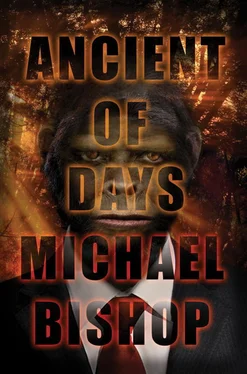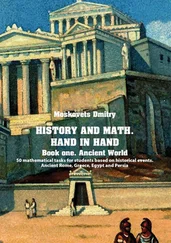Caroline continued to teach her classes and to conduct periodic interviews with the Cuban refugees still in detention in Atlanta’s aging federal prison. Like an armada of doomed mariners sailing toward the edge of the world, the Freedom Flotilla of 1980 kept receding into the past; and most of the prison’s current detainees had paperwork identifying them as hard-core criminals. Caroline had no wish to put these people out on the streets, but the cases of three or four young men deeply troubled her. She saw these prisoners as captives of a Kafkaesque bureaucracy and feared they would remain wards of the state forever.
Our marriage was working. Caroline never scolded me for letting the dental floss slip down into its plastic container, although I did that a lot. More important, neither of us currently wanted children. Later, T. P. having softened my objection to parenthood, we might consider adoption, but not now. There was too much to learn about each other and too much to do. We were learning. We were doing.
Montaraz is a Spanish word meaning wild, primitive , or uncivilized . As a masculine noun, it means forester . On the island by that name (a hand-shaped volcanic jut occupying about twenty-eight square miles in Manzanillo Bay), coffee plantations now compose the bulk of its accessible “forest.” A backpacker avoiding these industry-owned plantations might stumble upon a stand of mahogany or rosewood, but, for the most part, the island’s poor people have denuded the slopes to plant subsistence crops like cassava, yams, and beans. Today, then, a resident of Montaraz might fairly be called a farmer or a coffee-company employee, but none warrants the name of forester. A few who scrounge livings from neither private land nor industry jobs, however, do warrant labels such as wild and uncivilized , and many of these few included—at least until the early 1960s—the retiring descendants of the habiline slaves whom Louis Rutherford brought to Montaraz from Zanzibar in 1838. But their history is obscure, and many people alive today on Montaraz do not believe in them at all.
Most of the island’s population lives in the only noteworthy town, Rutherford’s Port, or in various fishing villages or tourist resorts along the many miles of twisty coast. In terms of health and economics, the native human population may be slightly better off than their counterparts on Haiti proper, but that assertion invites debate. Even a poverty-level citizen of Atlanta would incur envy in the waste archipelago of “Baby Doc” Duvalier’s rule.
Until 1822, Montaraz had belonged to Santo Domingo (now the Dominican Republic), but with Jean-Pierre Boyer’s subjugation of the Spanish-speaking sections of Hispaniola in that year, it became the property of Haiti. The Dominicans expelled the Haitians from their country in 1844, but by this time Louis Rutherford, an eminent American citizen, had acquired Montaraz by outright purchase. Therefore, although equidistant between Haiti and Santo Domingo, it was legally (albeit quite irregularly) another Caribbean territory of the United States. Rutherford died during the Dominican uprising against the Haitians, and followers of Pedro Santana quickly reclaimed the island as their own. Rutherford’s widow and grown sons protested to the new Democratic administration of James K. Polk, who had campaigned as an ardent expansionist, and Polk threatened the Dominicans with an invasion of marines. Judiciously, the Dominicans heeded the threat.
For another thirty years, then, the heirs of the late U.S. ambassador to Haiti ruled like kings on Montaraz. In 1874, however, Peter Martin Rutherford, the oldest grandson of the clan’s patriarch, negotiated an agreement with President Nissage Saget returning the island to Haitian sovereignty. This agreement gave the Rutherfords two important guarantees: (1) nonrescindable ownership of an estate occupying one fifth of the island, and (2) nonrevocable use of the English name Rutherford’s Port for the island’s only real town. Saget was able to conclude this agreement, where other Haitian leaders, notably Faustin Soulouque, had failed, because he was a sensible man with no major vices or reason-crippling ambitions. Peter Martin Rutherford liked him. The transfer was a fait accompli before the Dominicans had time to register the fact, and Montaraz has remained an unquestioned part of Haiti’s political sphere until the present day.
Montaraz appears on very few maps of the Caribbean. Early maps by Spanish cartographers feature it clearly enough, but maps drawn and printed during the twenty-year dictatorship of Boyer omit it completely. Although inescapable common knowledge to locals, the island’s presence in Manzanillo Bay remained obscure to outsiders through the 1870s because the Rutherfords did not wish to advertise it. After the negotiated Haitian takeover, however, Saget and his successors discouraged its appearance on maps as a peculiar kind of sop to Dominican pride. The Haitians apparently believed that if both sides pretended that Montaraz wasn’t there, their Spanish-speaking neighbors would shelve any strategies to reconquer it. You can’t plant a flag on invisible real estate. That the island was visible from the mid-northern coast of Hispaniola, if not on maps, both sides contentedly ignored.
Few Americans—few civilized people anywhere—had heard of Montaraz until Brian Nollinger broke the story of Adam’s presence on Paradise Farm to a reporter from the Atlanta Constitution . The notion that a habiline remnant might yet exist on the little island sent media people, anthropologists, professional adventurers, and scam artists scurrying for permission to visit Montaraz. Although American and Canadian citizens do not need passports to go to Haiti for thirty days or fewer, the Duvalier government—abetted by the Austin-Antilles Corporation, the licensed proprietor of most of the country’s coffee plantations—restricts travel to Montaraz to those who have made special application. In the wake of the story headlined REKNOWNED BEULAH FORK ARTIST / HARBORING PREHISTORIC HUMAN, these applications began arriving in Port-au-Prince by the bagful.
Very little came of this goal-oriented flurry of tourism, however, because the first eager visitors to Montaraz could find no habilines. They found blacks, mulattos, Spanish-Arawak survivors, jaded white Europeans, and affluent Japanese in polite, businesslike tour groups. They even found a puzzled party of middle-aged Kansans wearing Bermuda shorts, Italian sandals, and jaunty straw hats with green plastic visors. What they could not find, no matter how hard they searched, was anything remotely resembling a habiline. By this time, the government had placed a moratorium on issuing visitor permits to Montaraz, and word of the first arrivals’ lack of success began to migrate stateside. When Alistair Patrick Blair published his paper in Nature debunking Nollinger’s extravagant tale, interest in locating Adam’s relatives waned markedly. Pretty soon, applications to the Haitian Ministry of Tourism for special permits dwindled to the previous steady, but modest, level.
After the deluge, silence. More or less.
Anthropologists who accepted Dr. Nollinger’s contention that Adam was a living representative of Homo habilis , a manlike species presumed extinct for two million years, argued either that the Rutherford Remnant on Montaraz had been absorbed into the general population or that anti-Duvalier gunrunners and revolutionaries had press-ganged the habilines into service and scattered them across the Caribbean. (Anthropologists supporting Brian Nollinger, by the way, could be counted on one hand; the popular press canonized them as flamboyant idiot savants, good for human-interest copy but not for any reliable word on Adam’s origins.) Scientists opposed to Nollinger’s point of view declared that RuthClaire’s unusual husband was a small black man with certain archaic bone structures for which the processes of genetic atavism could easily account. No one could find other “habilines” on Montaraz because there were none . Adam was unique in many respects, but he did not depart so drastically from the human “norm,” whatever that might be, to require Linnaean pigeonholing as a protohuman. Besides, his intellectual capacity—his development of art, language, and a personal metaphysics—made nonsense of the idea that he was an evolutionary primitive.
Читать дальше












